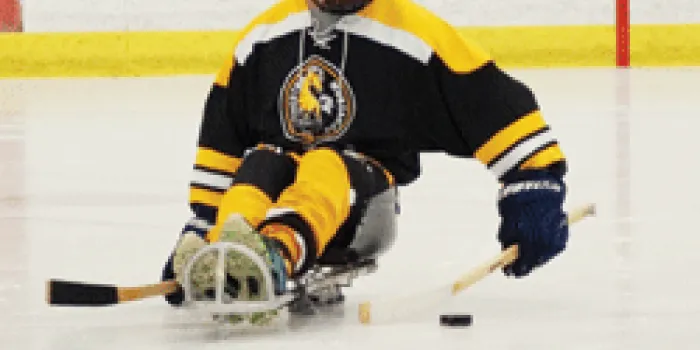In each issue of HemAware, we spotlight people in the bleeding disorders community. Here, we talk with Justin McClanahan, a 29-year-old from Rochester, Minnesota, about his involvement with the Rochester Mustangs, a sled hockey team. Justin has severe hemophilia A.
How does sled hockey differ from regular hockey?
It’s adaptive hockey. So you sit in what’s called a sled, with two blades in the back and a rubber guide in the front. You have two shortened sticks, which have ice picks on one end and regular hockey sticks on the other end. You use the ends with the picks to propel yourself and the other ends for shooting and puck handling.
How did you get involved with the Rochester Mustangs?
I grew up as an athletic kid and was on a basketball team when I was around 11 or 12. But because I had so much joint damage from early bleeds, I really wasn’t able to play team sports after that. Seven years ago, I had my right knee replaced, and last December I had my left ankle fused. I felt like I was never going to be able to find something to play until a buddy of mine who plays in an amateur adult league picked up a flyer for the Rochester Mustangs and gave it to me. Two weeks later I went to their board meeting, and two weeks after that I was learning how to play.
Tell us about the players on your team.
We have 11 players on the team, all with some sort of disability. We have several players with spinal cord injuries, who are paralyzed from the waist down. The youngest player on our team is 9 years old and he lost his legs in an accident. And then there’s me—left ankle fusion, right ankle replacement and severe hemophilia.
Why do you believe that participating in a sport like sled hockey is important for people with disabilities?
Everyone on the team has his own unique story about why he’s in that sled, and they’re all stories about having something being taken from you. When I’m playing, I feel like I’m taking something back that my disability has robbed me of. That’s the great thing about team sports, especially when you have a disability. It gives you back that feeling of control. When we’re on the ice, everyone is equal. Everyone is just part of the team.
How are you getting the word out about this new league?
We’re going to be playing a few exhibition games against teams with able-bodied players who will be using sleds. We’re excited about one in February, where we’ll play against local celebrities, like radio hosts and the chief of police. I’ve started Facebook and Twitter accounts for the Rochester Mustangs to try to raise our profile. I’m going to school for public relations, so I’m trying to use the skills I’m learning in school to help raise the profile of the team. Hopefully, people who may have felt that they could never play a team sport can find us and join.
Why do you feel it’s important for people with bleeding disorders to participate in sports?
I was born before prophylaxis became standard treatment for kids, so I didn’t start it until I was about 6 years old. By that point, I had already developed arthritis in my joints. But there are so many kids now who, because of good products and prophy, have no reason not to find a safe way to be active. I never wanted to let hemophilia run my life. By keeping active and keeping your muscles and joints strong, you can be in charge of your own life, rather than letting hemophilia dictate what you can do.

